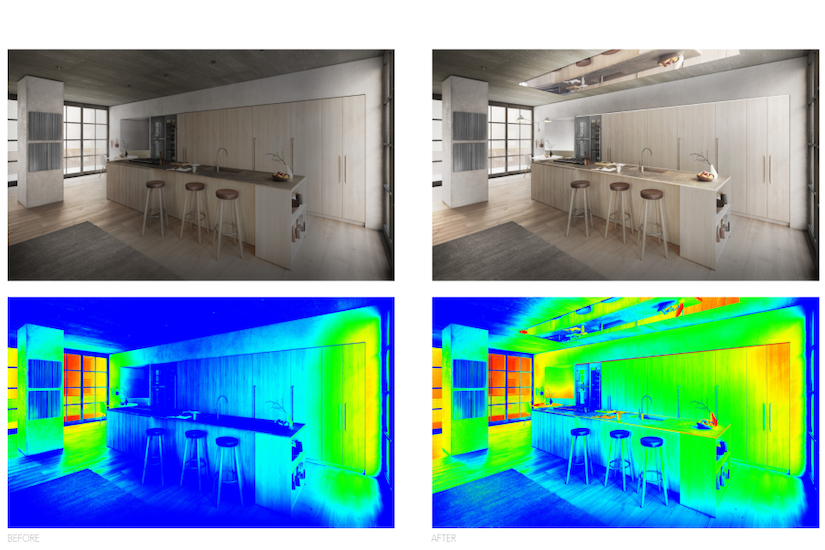With 91% of U.S. homeowners reporting that quality lighting is important to their home design and 75% noting that lighting is one of the most important design choices for their home (2023 Lutron Electronics/Harris Poll survey), designers are paying increasing attention to this increasingly critical feature.
Above: This interior illustrates how lighting can accentuate interiors with “pools” of light defining spaces, an approach championed by Sasha Bikoff of New York City-based Sasha Bikoff Design. sashabikoff.com, lutron.com Photo credit: © Magda Biernat Photography
There’s a spectrum of learning that accompanies working with light. Picking out decorative fixtures is the fun part. Knowing how to harness the powers of light in ways that benefit your clients – not just their homes – will set your design practice apart from the competition.
Seeing the Unseen

Documenting the ‘before’ kitchen with false-color photography (left), lighting designer Sara McElroy can zero in on its problems, including the puddle of darkness in the middle of the space. The same imaging technique used on the finished room (right) shows the solutions McElroy used to elevate and balance the light levels. She used lighter material choices to boost ambient light, while washing vertical surfaces to create a stronger sense of lit volume. Photo credit: Silver Shoe Design
Many designers eyeball lighting needs, working on instinct or past experience to create a scheme. For some small applications, like a wet bar, this approach may be sufficient. But in rooms with multiple light sources and functions, the process is more complex. Lighting designer and consultant Sara McElroy, founder and president of Brooklyn-based Silver Shoe Design, explains why she employs false-color imaging to analyze existing lighting conditions.
“False-color imaging serves as a crucial tool for comprehending relative brightness within a given environment. In our field, there’s often an overemphasis on delivered light, overlooking the significance of luminance – the actual brightness of our surroundings,” McElroy said. “Luminance forces consideration of the elements that receive light, as well as the position of the person viewing the environment. By scrutinizing light with a focus on surface value, we can effectively map and comprehend luminous contrast within a space.”
This approach allows the designer to prioritize designing visual hierarchy in environments, ensuring that each element receives adequate illumination relative to its importance and function.
Asked how she uses this technology to develop lighting solutions, McElroy explained, “A balanced luminous environment is essential for visual comfort, as it minimizes harsh contrasts and reduces eye strain. False-color imaging becomes an invaluable addition to our toolkit in achieving this objective. It aids in visualizing the distribution of brightness variations, which correlates with luminance, enabling us to strategically plan lighting solutions that optimize both visual comfort and aesthetic appeal. By carefully considering luminance levels and utilizing false-color imaging to analyze and adjust lighting designs, we can enhance the overall quality of the visual environment, promoting wellbeing and productivity. Ultimately, by incorporating false-color imaging into our design process, we enhance our ability to create spaces with well-defined visual hierarchy and balanced luminous contrast.”
Interior Influences on Lighting

The Novy Shelf Pro has smart sensors fitted along the length of the ledge, enabling the Gesture Control Pro feature. It lets users “drag” the LED light beam with their hand to where it’s needed. In six lengths in black or white. novy.com Photo credit: Novy
Industry observations made by the American Lighting Association (ALA) show how design trends are influencing lighting choices in the kitchen. Among its findings:
Countertops Impact Lighting. While granite is still used in entry- and mid-level homes, most high-end countertops are now quartz-based, with matte finishes remaining in vogue. Specifying a leathered finish alleviates the tricky business of providing adequate illumination in kitchens without causing glare from glossy countertops.
Dark Appliances Require More Light. While a black stainless finish on appliances eliminates unsightly fingerprints, it soaks up light, creating the need for additional illumination in the surrounding space. Black stainless has lower reflectance than white or stainless steel appliances, making the room appear darker.
Taller Ceilings Need Taller Fixtures. Over the past decade, residential ceiling heights have risen, with 9 feet becoming the accepted minimum height. It’s not uncommon for North American homes to have ceilings 10 to 12 feet high. This condition requires taller sconces and taller chandeliers to fill the additional space. Designers need to note that this is not simply a question of physical or spatial proportion – the quantity and quality of light itself should be carefully considered.
Lighting for Health and Wellness

Intelligent lighting design is essential to human health. Circadian-based systems have been proven to improve sleep habits. A new product for the bath, Sunshower (above), is a radiant panel that is designed for installation inside the shower enclosure or other humid environments. Fitted with lamps that emit infrared and/or low-dose UV rays, it can deliver the benefits of natural light in just a few minutes.
Lighting becomes more important as people age. With Baby Boomers reaching their mid-60s, designers are well advised to take their clients’ ages into account when planning their home lighting design. Terry McGowan, director of engineering for the ALA, said, “Older eyes experience two important changes.”
First, the amount of light required to sustain visual performance increases with age. Research shows that a 60-year-old needs twice as much light as a 30-year-old to accomplish daily tasks in safety and comfort.
The second change in visual perception over time is that eyes become increasingly sensitive to glare. This can seem like a bit of a Catch-22; simply upping the amount of light in a room can often result in heightened glare. It’s equally important to regulate the quality of light as people grow older.
In a New Light
As the art and science of lighting evolves, designers will have greater opportunities to explore and apply its power to their work. Its potential has been described by environmental artist James Turrell, who said, “Light is not so much something that reveals, as it is itself the revelation.”








